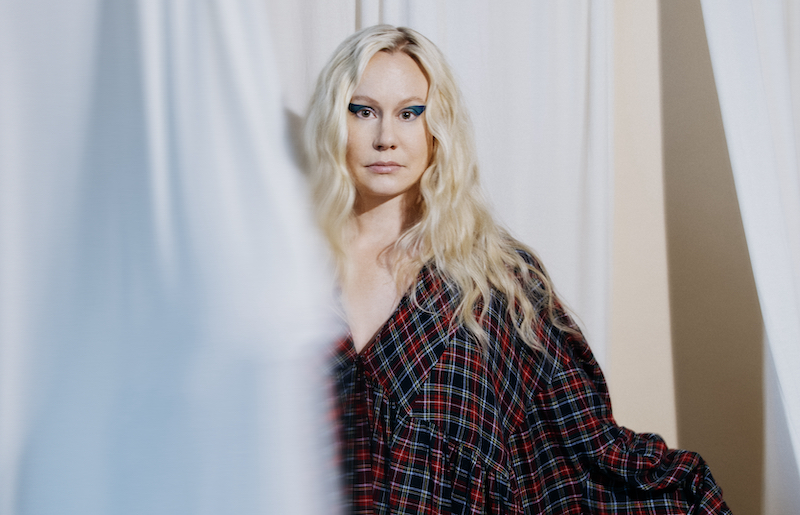Norwegian arstist Susanna (aka Susanna Wallumrød), has always pushed boundaries, searched for different angles and combined different aspects of art into her work. Thats seen her interpret poetry and art, as well as give a fresh take on songs; her take on Purcell’s early English Opera aria ’When I am laid (in Earth) still sends shivers through me.
Out now is her new album ’Elevation’, on her own SusannaSonata label, and its a typically gorgeous set of songs – once again inspired by the works of French poet Charles Baudelaire, as was its predecessor, 2020’s Baudelaire & Piano. This time she has combined tape loops, spoken word and song to make something not just artistic, but beautiful and memorable as well.
We spoke to Susanna, and bandmates Delphine Dora and Stina Stjern, who gave us their thoughts and insights on the album, track by track.
1. Alchemy of Suffering (Susanna)For this album I have chosen poetry of Charles Baudelaire (1821-1867) that speaks of various processes and journeys, within ourselves, that we embark on as human beings, as spiritual animals. The melody for the Alchemy of Suffering came to me clearly from reading the poem, and the piano is like a stream beneath it. Together with sounds from Stina Stjern’s tape recorders and cassette tapes, this has turned out to be a modern experimental hymn.
2. Ciel brouillé (Delphine Dora)This poem speaks of the relationship between Baudelaire and his muse of the moment, Marie Daubrun, with whom he lived 10 years of a passionate and intellectual love. This poem is entirely based on a comparison between the woman and the climate. It is a cold woman with a moody character, which leads to a relationship doomed to failure between the poet and his muse.
3.Rose-Pale Dawn (Stina Stjern)I have had the pleasure of working with compositions for cassette tapes and walkmans in the concert performance of “Susanna, Baudelaire and Piano” in 2020. On “Elevation” I wanted to take this work further and enter the composition process from a different angle. Where my early cassette compositions have to a greater extent been sound collages, the compositions on «Elevation» are based on several original sound recordings where I cultivate fewer elements and use several cassettes with the same sound source. I had more focus on the overall form of the compositions. On “Rose-Pale Dawn”, I wanted to create something that for me symbolised an airy texture inspired by pastel colours and the soft, but sometimes dramatic sky in the hours between night and day.
4.L’aube Spirituelle (Delphine Dora)This traditionally written sonnet describes the poet’s morning wanderings at dawn, after a night of debauchery, and he seems to find light in the memory of his beloved woman.
5. Elevation (Susanna)A skeletal piano-melody and Stina Stjern’s evocative cassette tapes makes the setting for my vocal interpretation of this gorgeous poem. Humans seeking a transcendent state of being is hardly a new concept; either through religion, meditation, rituals, different forms of spiritual awakening or even drugs. Seems like Baudelaire made acquaintance with several of those concepts. Nonetheless, he wrote these transcending words – beautiful vivid images of the human condition.
6. Alchimie De La Douleur (Delphine Dora)The poetic work is defined as an alchemical operation, which consists in drawing “flowers” from evil, in transforming mud into gold. It is a real transfiguration that defines the poetic work.The alchemy of pain can be read in two ways: on the one hand, the poetic alchemy is painful, on the other hand, it can nevertheless allows a sublimation of negative feelings.
7. Le Possédé (Delphine Dora)This poem present the poet as a willing or helpless victim of the beloved woman, of her cruelty and of her destructive power.
8. Light Up Your Eyes (Stina Stjern)This short piece consists of a rhythmic cassette loop that can send associations to a vinyl player befriending dust particles. In reality these are sounds of me accidentally touching my phone while doing field recordings. The rest of the piece is based on the somewhat underrated instrument triangle as sound source. In this piece I use a pitch-control on my walkman to disguise the original sound and give the whole it`s own texture. It’s a bit like I read Baudelaire too: The use of words that give a separate association in themselves, but which give a completely different and often surprising meaning in the context.
9. Invitation to the Voyage (Susanna)Oh what wonderful words. This poem invites the music to be made, the words to be sung, the images to be seen. Invitation to the Voyage was the first Baudelaire-poem I put music to, and on this record it’s played totally solo, stripped back to piano and vocals.
10. Le Vin Des Amants (Delphine Dora)“Le vin des amants” is a rather positive poem. The poet expresses how he feels when he reconciles love and alcohol and tells us about the feeling of escape that comes with it.
11. In Shared Ecstasy (Stina Stjern)As a basis for this composition, I have used the sound of the strings from an auto-harp. This is also meant as a sonic nod to Susanna’s piano and her compositions. Quite early on a field recording of crows is introduced. Susanna made this recording on a cemetery close to her home in Oslo. This is a place where we have met often during the pandemic and where we have had conversations about Baudelaire and deep personal experiences and processes. The crows therefore symbolise a passage in time where Baudelaire’s work resonated deeply with our own lives and work.
12. Destruction (Susanna)The Devil knows all our vices, all the temptations, all the taboos. There is powerful forces in desires, whatever you desire. And there is things to learn and experience about yourself in the heat of it all. But it can easily turn into an addiction. “The longer you desire The Devil, the harder it is to stop.” (quote from Sabat Magazine’s Le Tarot De L’Étoile Cachée)














No Comment